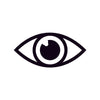This is one of the most common and popular diagnostic tests for colour vision deficiency. The patient is shown a series of specially designed pictures composed of coloured dots and is asked to look for numbers among them. Individuals with a colour vision deficiency do not see them of they will make mistakes.
This test can determine if a colour vision deficiency exits and the type of it. However, additional testing may be needed to determine the exact nature and degree of deficiency.
A person would have poor colour vision and not know it. A lot of times, people with red-green deficiency are not aware of the problem because they have learned to see the ‘right’ colour. For example, tree leaves are green, so they call the colour they see ‘green’. This can happen quite often on children. Early detection is vital since many learning materials rely heavily on colour perception and colour coding. There are also colour-blind friendly colours that can help people, experiencing this condition, differentiate between those colours. Colour vision deficiency may also exclude people participating in certain jobs, e.g., driving a fire truck and ambulance, being an electrician, etc. Colour blind glasses may improve the contrast between certain colours but only if the colour vision deficiency is mild.
The take-home-message here is, if you suspect yourself or your family members might have colour vision deficiency, raise the issue with your optometrist and get tested. Though there is no definite treatment for colour blindness if it’s inherited, early detection and quantitative analysis are vital as there are numerous little tricks you can do to make your life easier.
By Eileen H.
Optometrist at 1001 Optometry
Need an eye test? BOOK NOW


